
Hayao Miyazaki is a Japanese animator, filmmaker, and manga artist. He co-founded Studio Ghibli and serves as its honorary chairman. Over the course of his career, Miyazaki has attained international acclaim as a masterful storyteller and creator of Japanese animated feature films, and is widely regarded as one of the most accomplished filmmakers in the history of animation.

Vitruvius was a Roman architect and engineer during the 1st century BC, known for his multi-volume work titled De architectura. As the only treatise on architecture to survive from antiquity, it has been regarded since the Renaissance as the first book on architectural theory, as well as a major source on the canon of classical architecture. It is not clear to what extent his contemporaries regarded his book as original or important.
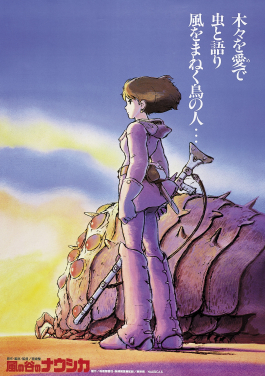
Nausicaä of the Valley of the Wind is a 1984 Japanese animated post-apocalyptic fantasy film written and directed by Hayao Miyazaki, based on his 1982–94 manga series of the same name. It was produced by Topcraft and distributed by Toei Company. Joe Hisaishi, in his first collaboration with Miyazaki, composed the score. The film stars the voices of Sumi Shimamoto, Gorō Naya, Yōji Matsuda, Yoshiko Sakakibara and Iemasa Kayumi. Set in a post-nuclear futuristic world, it tells the story of Nausicaä (Shimamoto), the pacifist teenage princess of the Valley of the Wind who becomes embroiled in a struggle with Tolmekia, an empire that attempts to use an ancient weapon to eradicate a jungle populated by oversized, mutant insects.

Studio Ghibli, Inc. is a Japanese animation studio based in Koganei, Tokyo. It has a strong presence in the animation industry and has expanded its portfolio to include various media formats, such as short subjects, television commercials, and two television films. Their work has been well received by audiences and recognized with numerous awards. Their mascot and most recognizable symbol, the character Totoro from the 1988 film My Neighbor Totoro, is a giant spirit inspired by raccoon dogs (tanuki) and cats (neko). Among the studio's highest-grossing films are Princess Mononoke (1997), Spirited Away (2001), Howl's Moving Castle (2004), Ponyo (2008), and The Boy and the Heron (2023). Studio Ghibli was founded on June 15, 1985, by the directors Hayao Miyazaki and Isao Takahata and producer Toshio Suzuki, after acquiring Topcraft's assets.

An automaton is a relatively self-operating machine, or control mechanism designed to automatically follow a sequence of operations, or respond to predetermined instructions. Some automata, such as bellstrikers in mechanical clocks, are designed to give the illusion to the casual observer that they are operating under their own power or will, like a mechanical robot. The term has long been commonly associated with automated puppets that resemble moving humans or animals, built to impress and/or to entertain people.

Badīʿ az-Zaman Abu l-ʿIzz ibn Ismāʿīl ibn ar-Razāz al-Jazarī was a Muslim polymath: a scholar, inventor, mechanical engineer, artisan and artist from the Artuqid Dynasty of Jazira in Mesopotamia. He is best known for writing The Book of Knowledge of Ingenious Mechanical Devices in 1206, where he described 50 mechanical devices, along with instructions on how to construct them. He is also known as father of robotics as his works laid foundation for the development of modern robotics. One of his more famous inventions is the elephant clock. He has been described as the "father of robotics" and modern day engineering.

The Tower of the Winds, known as the Ωρολόγιο του Κυρρήστου in Greek, and by other names, is an octagonal Pentelic marble tower in the Roman Agora in Athens, named after the eight large reliefs of wind gods around its top. Its date is uncertain, but was completed by about 50 BC, at the latest, as it was mentioned by Varro in his De re Rustica of about 37 BC. It is "one of the very small number of buildings from classical antiquity that still stands virtually intact", as it has been continuously occupied for a series of different functions.
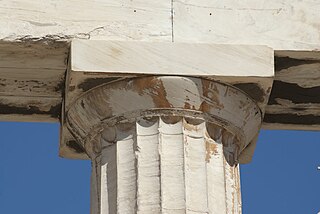
In architecture, the capital or chapiter forms the topmost member of a column. It mediates between the column and the load thrusting down upon it, broadening the area of the column's supporting surface. The capital, projecting on each side as it rises to support the abacus, joins the usually square abacus and the usually circular shaft of the column. The capital may be convex, as in the Doric order; concave, as in the inverted bell of the Corinthian order; or scrolling out, as in the Ionic order. These form the three principal types on which all capitals in the classical tradition are based.

A water clock or clepsydra is a timepiece by which time is measured by the regulated flow of liquid into or out from a vessel, and where the amount of liquid can then be measured.

Seiko Group Corporation, commonly known as Seiko, is a Japanese maker of watches, clocks, electronic devices, semiconductors, jewelry, and optical products. Founded in 1881 by Kintarō Hattori in Tokyo, Seiko introduced the world's first commercial quartz wristwatch in 1969.

An aeolipile, aeolipyle, or eolipile, from the Greek "Αἰόλου πύλη," lit. 'Aeolus gate', also known as a Hero'sengine, is a simple, bladeless radial steam turbine which spins when the central water container is heated. Torque is produced by steam jets exiting the turbine. The Greek-Egyptian mathematician and engineer Hero of Alexandria described the device in the 1st century AD, and many sources give him the credit for its invention. However, Vitruvius was the first to describe this appliance in his De architectura.

A striking clock is a clock that sounds the hours audibly on a bell, gong, or other audible device. In 12-hour striking, used most commonly in striking clocks today, the clock strikes once at 1:00 am, twice at 2:00 am, continuing in this way up to twelve times at 12:00 mid-day, then starts again, striking once at 1:00 pm, twice at 2:00 pm, and the pattern continues up to twelve times at 12:00 midnight.
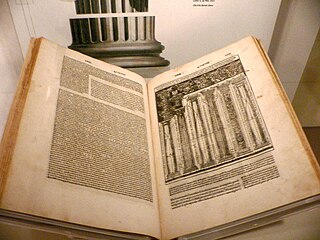
De architectura is a treatise on architecture written by the Roman architect and military engineer Marcus Vitruvius Pollio and dedicated to his patron, the emperor Caesar Augustus, as a guide for building projects. As the only treatise on architecture to survive from antiquity, it has been regarded since the Renaissance as the first known book on architectural theory, as well as a major source on the canon of classical architecture.
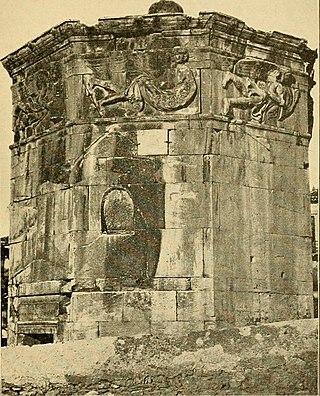
An anemoscope is a device designed to show the direction of the wind, or to indicate a change of wind direction. The name is usually applied to an apparatus consisting of a wind vane above, connecting to a building below by some kind of coupling, and with a dial or index with pointers to show the direction and changes of the wind.

Plaza Senayan is a shopping mall located in Central Jakarta, Indonesia. The mall is a few minutes by car from the Semanggi area; offering shops and services such as designer goods and gourmet food. In January 2017, Forbes recognized Plaza Senayan as one of the top five shopping malls in Jakarta.
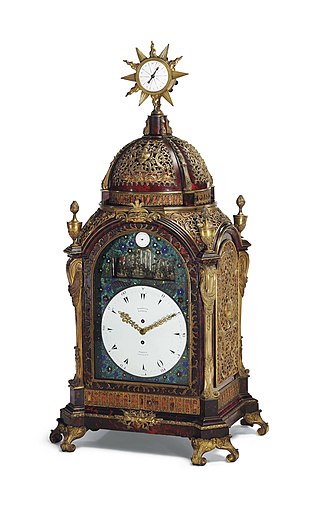
A musical clock is a clock that marks the hours of the day with a musical tune. They can be considered elaborate versions of striking or chiming clocks.
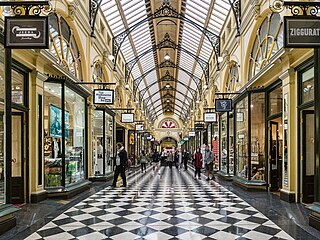
The Royal Arcade is a historic shopping arcade in the central business district of Melbourne, Victoria, Australia. Opened in 1870, it connects Bourke Street Mall to Little Collins Street, with a side offshoot to Elizabeth Street. It is the oldest surviving arcade in Australia, known for its elegant light-filled interior, and the large carved mythic figures of Gog and Magog flanking the southern entry.
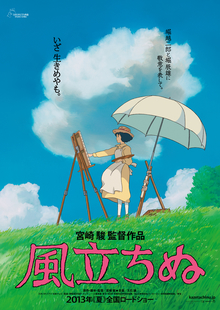
The Wind Rises is a 2013 Japanese animated historical drama film written and directed by Hayao Miyazaki based on his 2009 manga The Wind Rises. Produced by Studio Ghibli and distributed by Toho, the film stars the voices of Hideaki Anno, Miori Takimoto, Hidetoshi Nishijima, Masahiko Nishimura, Morio Kazama, Keiko Takeshita, Mirai Shida, Jun Kunimura, Shinobu Otake, and Nomura Mansai.

Mia Araujo is an Argentine-American painter who is best known for her elaborate and detailed works of surrealist and fantasy imagery. Her work has been shown in internationally recognized galleries, including Roq La Rue Gallery, in Seattle, Corey Helford Gallery, in California, Haven Gallery in Northport, New York, and Dorothy Circus Gallery, in Rome, Italy. Her work has been prominently featured in such high profile arts publications as Hi-Fructose Magazine, Juxtapoz, and Society of Illustrators of Los Angeles.
Rhythm Co., Ltd., formerly Rhythm Watch until 2020) is a Japanese global corporate group based in Saitama, Japan. The company was founded in 1950 as a clock company and has since expanded globally as a manufacturer of watches, clocks, precision equipment, connectors and small displays. From 1955 until 2003 it was headquartered in Tokyo.





















